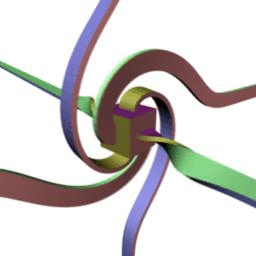The Difference Between Rotation and Spin
The difference between rotation (an object’s parts are revolving around its center) and here, true spin, which is a fundamental property of 3 dimensional space – very cool. This is the answer to the following question: Can a region of space rotate while still being connected to its neighboring points, and that to its neighboring point, etc., without ripping the space or tangling it so it gets wound tighter and tighter? If you study the animation, and the one below it, you can see how it’s done. In each direction extending outward from the center, the space is twisted as it revolves and get lifted enough to allow other parts of the space, say underneath it, over the course of a full turn. Then over the course of a second turn it untwists while allowing other parts of the space over it. All elementary particles that are not involved in transmitting forces are called spinors: electrons, protons, neutrons behave like this. They have to spin two complete rotations to get back to their original configuration.

In quantum physics you learn that spin is a type of angular momentum with no classical counterpart. This is simply not true. Spin can be shown to be a feature of a classical field by Noether’s Theorem. The reason it is considered quantum is that wherever you encounter spin in everyday life, like a spinning top for example, its parts (atoms) are not actually rotating – they are revolving around its center. To get actual spin it must be a quantum-sized system, else it will just be composed of parts revolving around its center. Here is a more complete version.
